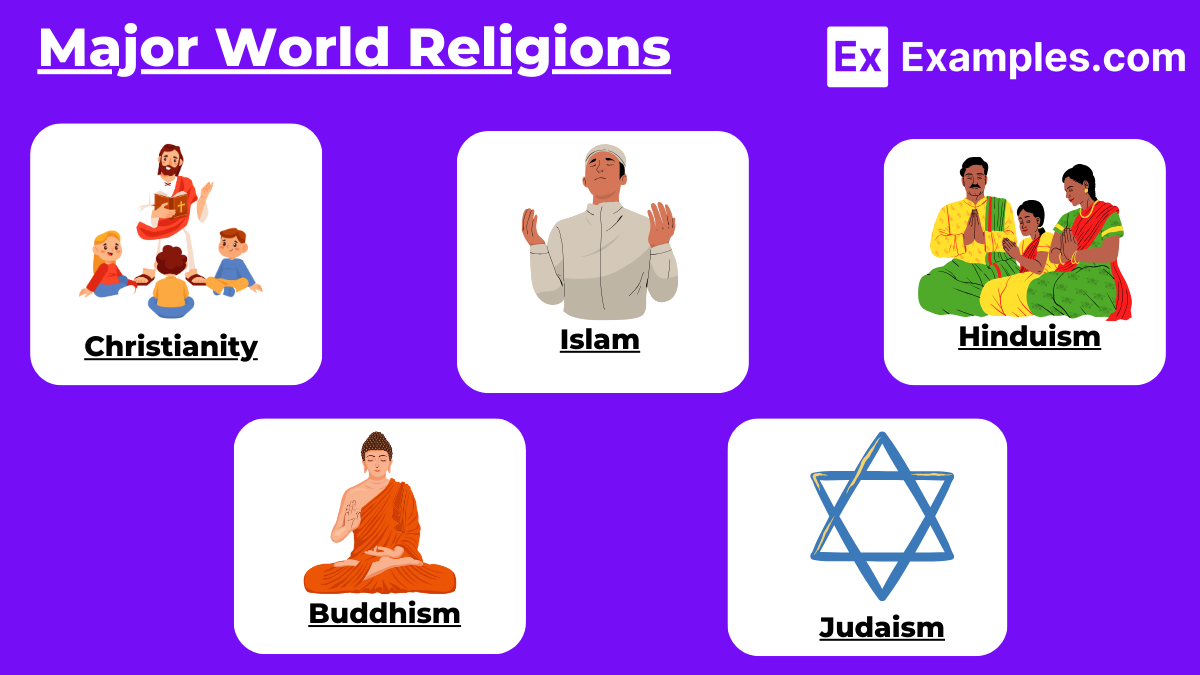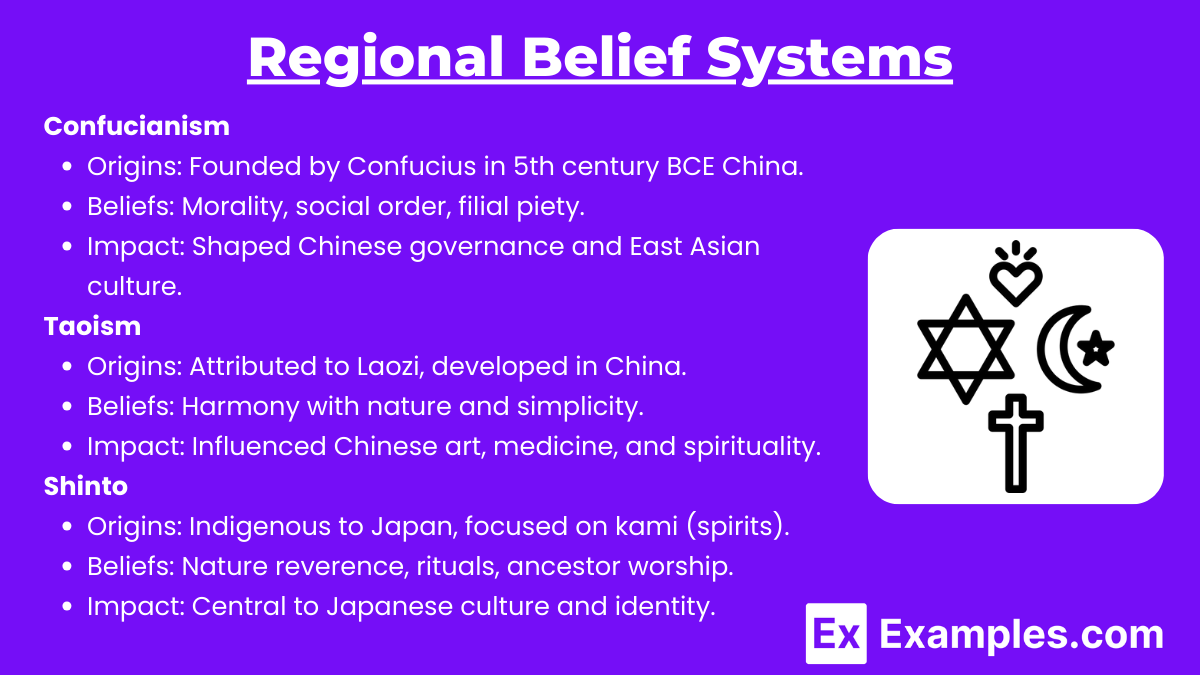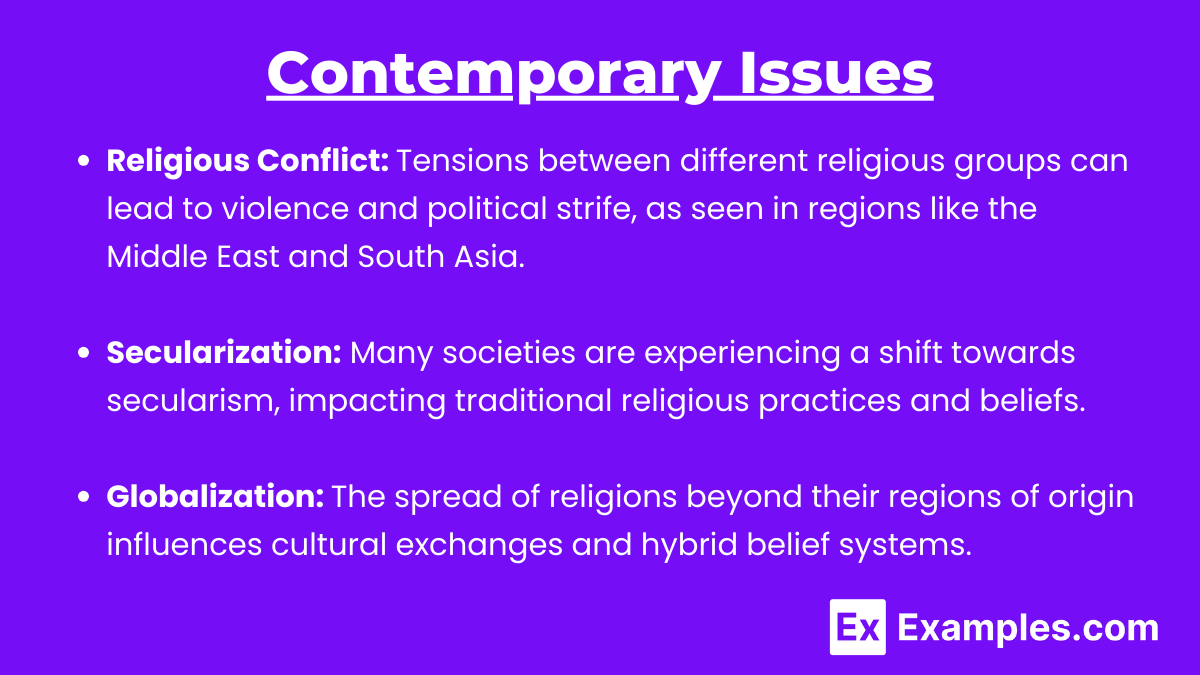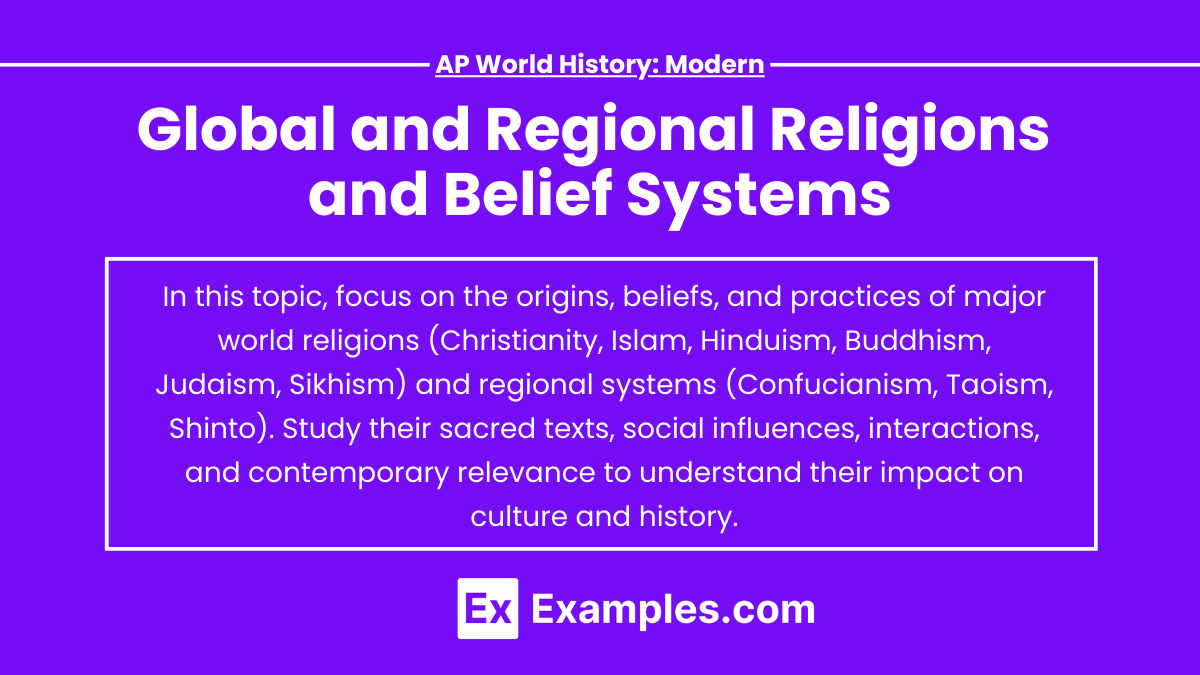Global and regional religions and belief systems play a crucial role in shaping cultures, societies, and historical events. They encompass a diverse array of faiths, each with unique practices, sacred texts, and ethical teachings. From the major world religions like Christianity and Islam to regional traditions such as Shinto and indigenous spiritualities, these belief systems influence individual identities and collective values. Understanding their significance helps illuminate the complexities of human experience and cultural diversity throughout history.
Learning Objectives
In studying Global and Regional Religions and Belief Systems for AP World History: Modern, you should identify major religions such as Christianity, Islam, Hinduism, Buddhism, Judaism, and Sikhism, along with their origins, key beliefs, and practices. Examine regional belief systems like Confucianism, Taoism, Shinto, and indigenous spiritualities, assessing their cultural significance. Familiarize yourself with sacred texts, such as the Bible and Quran, and evaluate how religions influence social structures and political systems. Analyze interactions between different religious groups, including syncretism and conflict, and understand the modern implications of these belief systems in social movements and globalization. Finally, compare core beliefs and reflect on how these religions shape personal values and cultural diversity, leading to a comprehensive understanding of their historical and contemporary importance.
1. Major World Religions

- Christianity
- Origins: Emerged in the 1st century CE from Judaism, centered on the teachings of Jesus Christ.
- Key Beliefs: Monotheism, the Trinity, salvation through faith, and the importance of the Bible.
- Branches: Major branches include Catholicism, Protestantism, and Eastern Orthodoxy.
- Impact: Spread through missionary work, colonization, and cultural exchanges; influenced Western ethics, law, and art.
- Islam
- Origins: Founded in the 7th century CE by the Prophet Muhammad in Mecca.
- Key Beliefs: Monotheism (Allah), the Five Pillars of Islam, the Quran as the holy text.
- Branches: Sunni and Shia are the two main sects.
- Impact: Significant cultural, scientific, and philosophical contributions during the Golden Age of Islam; influenced trade, architecture, and governance.
- Hinduism
- Origins: One of the oldest religions, with roots tracing back over 4,000 years in the Indian subcontinent.
- Key Beliefs: Polytheism, dharma (duty), karma (action and consequence), and moksha (liberation from the cycle of rebirth).
- Caste System: Social stratification based on religious and occupational roles.
- Impact: Influenced Indian culture, art, and philosophy; spread through migration and trade.
- Buddhism
- Origins: Founded in the 6th century BCE by Siddhartha Gautama (the Buddha) in India.
- Key Beliefs: Four Noble Truths, Eightfold Path, impermanence, and the goal of achieving Nirvana.
- Branches: Theravada and Mahayana are the primary schools.
- Impact: Spread throughout Asia, influencing cultures, art, and political structures; emphasizes compassion and mindfulness.
- Judaism
- Origins: One of the oldest monotheistic religions, with roots in ancient Israel.
- Key Beliefs: Covenant with God, importance of the Torah, and ethical monotheism.
- Impact: Influenced Christianity and Islam; has a significant cultural and historical presence in the Western world.
2. Regional Belief Systems

- Confucianism
- Origins: Developed in China by Confucius in the 5th century BCE.
- Key Beliefs: Emphasis on morality, social relationships, and filial piety.
- Impact: Shaped Chinese governance, education, and social structures; influenced East Asian cultures.
- Taoism
- Origins: Founded in China around the same time as Confucianism, attributed to Laozi.
- Key Beliefs: Harmony with the Tao (the Way), simplicity, and naturalness.
- Impact: Influenced Chinese art, medicine, and spirituality; promotes environmental harmony.
- Shinto
- Origins: Indigenous religion of Japan focusing on kami (spirits).
- Key Beliefs: Reverence for nature, rituals, and ancestors.
- Impact: Integral to Japanese culture, festivals, and national identity.
3. Contemporary Issues

- Religious Conflict: Tensions between different religious groups can lead to violence and political strife, as seen in regions like the Middle East and South Asia.
- Secularization: Many societies are experiencing a shift towards secularism, impacting traditional religious practices and beliefs.
- Globalization: The spread of religions beyond their regions of origin influences cultural exchanges and hybrid belief systems.
Examples
Example 1 : Judaism
Judaism is one of the oldest monotheistic religions, originating around 2000 BCE in the ancient Near East. It is based on the belief in a single, all-powerful God and the covenant between God and the Israelites, as described in the Hebrew Bible (Tanakh). Key practices include observing the Sabbath, dietary laws (kashrut), and celebrating holidays such as Passover and Yom Kippur. Judaism has had a profound influence on Western civilization, serving as the foundation for both Christianity and Islam.
Example 2 : Sikhism
Sikhism was founded in the 15th century in the Punjab region of India by Guru Nanak. It emphasizes the belief in one God, equality of all people, and community service. The teachings are based on the Guru Granth Sahib, the central religious scripture. Sikh practices include daily prayers, meditation, and participating in community kitchens (langar). Sikhism has spread globally, particularly in the United Kingdom, Canada, and the United States, and has made significant contributions to social justice and humanitarian efforts.
Example 3 : Taoism
Taoism, which originated in ancient China around the 4th century BCE, is a philosophical and religious tradition centered on living in harmony with the Tao, or “the Way.” Key texts include the Tao Te Ching, attributed to Laozi. Taoism emphasizes simplicity, humility, and compassion, advocating for a lifestyle that aligns with the natural world. It has influenced Chinese culture, medicine, and arts, and continues to be practiced, offering insights into environmentalism and holistic living.
Example 4 : Shinto
Shinto is the indigenous spirituality of Japan, focusing on the worship of kami, or spirits, that inhabit natural objects and phenomena. It emphasizes rituals, festivals, and a deep respect for nature and ancestors. Shinto practices include visiting shrines, purification rituals, and seasonal celebrations. Although Shinto coexists with Buddhism in Japan, it retains a distinct cultural identity and plays a crucial role in shaping Japanese customs, festivals, and community life.
Example 5 : Indigenous Belief Systems
Indigenous belief systems encompass a wide range of spiritual practices and worldviews that are specific to various ethnic groups around the world. These systems often emphasize a deep connection to nature, ancestral spirits, and community traditions. For example, many Native American spiritualities focus on harmony with the environment and the sacredness of the land. These belief systems are characterized by oral traditions, rituals, and a holistic understanding of life, reflecting the diverse cultures and histories of indigenous peoples globally.
Multiple Choice Questions
Question 1
Which of the following is a key belief in Buddhism?
A) The Trinity
B) The Four Noble Truths
C) The Eightfold Path
D) Both B and C
Correct Answer: D) Both B and C
Explanation: Buddhism centers around the Four Noble Truths, which outline the nature of suffering and the path to enlightenment. The Eightfold Path provides a practical guide to ethical and mental development with the goal of freeing the individual from attachments and delusions, ultimately leading to nirvana. Both concepts are fundamental to Buddhist teachings.
Question 2
What is the primary sacred text of Sikhism?
A) The Vedas
B) The Bible
C) The Quran
D) The Guru Granth Sahib
Correct Answer: D) The Guru Granth Sahib
Explanation: The Guru Granth Sahib is the central religious scripture of Sikhism, containing the teachings of the Sikh Gurus and other saints. Unlike other religions that may have multiple texts, Sikhism considers the Guru Granth Sahib to be the eternal Guru after the ten human Gurus, emphasizing its significance in guiding followers’ spiritual lives.
Question 3
In which country is Shinto primarily practiced?
A) China
B) India
C) Japan
D) Korea
Correct Answer: C) Japan
Explanation: Shinto is the indigenous spirituality of Japan, deeply rooted in the country’s culture and history. It focuses on the worship of kami (spirits) associated with natural elements, ancestors, and various aspects of life. While Buddhism also has a significant presence in Japan, Shinto remains a distinct and vital part of Japanese identity and tradition.


